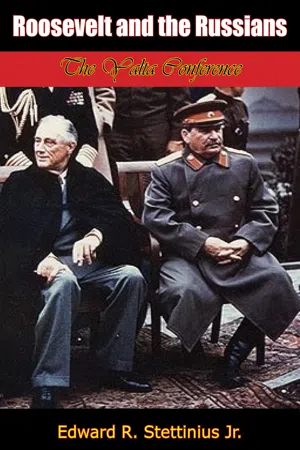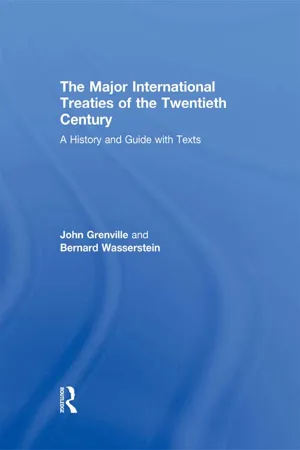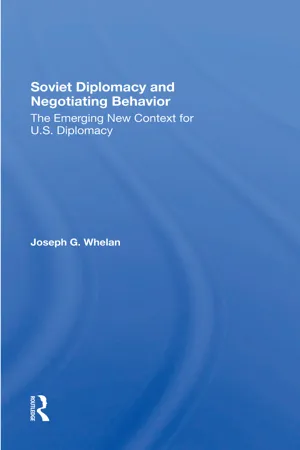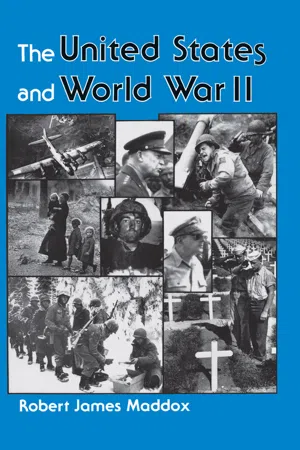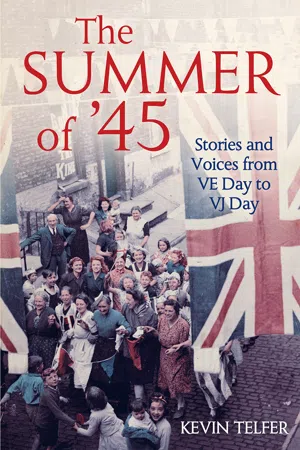History
Tehran Conference
The Tehran Conference was a meeting held in Tehran, Iran, in 1943 during World War II. It was attended by the leaders of the United States, the Soviet Union, and the United Kingdom, namely Franklin D. Roosevelt, Joseph Stalin, and Winston Churchill. The conference focused on coordinating military strategy and discussing post-war plans, laying the groundwork for future Allied cooperation.
Written by Perlego with AI-assistance
Related key terms
5 Key excerpts on "Tehran Conference"
- eBook - ePub
Roosevelt and the Russians
The Yalta Conference
- Edward R. Stettinius Jr.(Author)
- 2017(Publication Date)
- Eschenburg Press(Publisher)
PART ONE—TRYING TO BUILD A BETTER WORLD
CHAPTER 1—Background of the Yalta Conference
The Yalta Conference—February 4–11, 1945—was the most important wartime meeting of the leaders of Great Britain, the Soviet Union, and the United States. It was not only the longest meeting of President Roosevelt with Prime Minister Churchill and Marshal Stalin; it was also the first time that the three leaders reached fundamental agreements on post-war problems as distinct from mere statements of aims and purposes. Many problems of a non-military nature had been discussed at Teheran, but basic agreements were not reached or even attempted.This was the second time the three war leaders had met, but it was the first occasion on which they had met with all their foreign ministers. Although Anthony Eden and V. M. Molotov had participated in the Teheran Conference—November 28–December 1, 1943—Cordell Hull had not.The Yalta Conference, too, was the first real occasion on which the Chiefs of Staff of the three countries conducted an exhaustive examination of the respective military positions of the Allied forces and discussed in detail their future plans. The timing of the second front and related military questions had been discussed at Teheran, but it was not until Yalta that sufficient confidence existed among the three nations for a free and open examination of future operational plans.Thus the Yalta Conference marked the high tide of British, Russian, and American co-operation on the war and on the post-war settlement. In the days immediately after the Conference most American newspapers gave high praise to what had been accomplished in the Crimea. - eBook - ePub
The Major International Treaties of the Twentieth Century
A History and Guide with Texts
- John Grenville, Bernard Wasserstein(Authors)
- 2013(Publication Date)
- Routledge(Publisher)
Declarations on General Security, Italy, Austria, and German Atrocities, 30 October 1943.The Cairo Conference took place on 22–26 November 1943 (Roosevelt, Churchill, Chiang Kai-shek). The Russians would not attend since they were not at war with Japan. Besides military strategy in the Far East, the post-war settlement there was discussed. The final communiqué outlined the territorial peace terms the three Allies would impose on Japan, and promised Korea independence in due course.Roosevelt and Churchill next flew to Persia to participate with the Russians in the Teheran Conference (Churchill, Roosevelt, Stalin, Eden, Hopkins, Combined Chiefs of Staff) 28 November–1 December 1943. The military situation in Europe and the Far East was discussed. Stalin declared the Soviet Union would join in the war against Japan after victory over Germany. There were exploratory discussions concerning the future of France, Germany and Poland. Roosevelt initiated a discussion on the establishment of a post-war international organization to preserve peace and security. It was agreed that ‘Overlord’, the Anglo-American invasion of northern France, would take place on 1 May 1944. Turkey and Italy were discussed. No formal written agreement was reached on the Soviet Union’s and Poland’s western frontiers, though Churchill agreed to the Curzon line as a basis and to the acquisition by Poland of German territory east of the Oder river. A declaration promised to Iran independence and territorial integrity. A communiqué on the results of the conference was published on 6 December 1943.More than a year elapsed after the conclusion of the Teheran Conference until Churchill, Roosevelt and Stalin met again at Yalta in February 1945. Meantime Roosevelt and Churchill and the Combined Chiefs of Staff had met at Quebec, 11–19 September 1944 to discuss future policy towards Germany; Churchill flew to Moscow to discuss post-war spheres of influence, the Balkans and Poland, with Stalin; Harriman attended as an observer from 9–20 October 1944. Shortly before Yalta, the Combined Chiefs of Staff, Churchill, Eden and Stettinius met at Malta, 30 January–3 February 1945 - eBook - ePub
Soviet Diplomacy And Negotiating Behavior
The Emerging New Context For U.s. Diplomacy
- Joseph G. Whelan(Author)
- 2019(Publication Date)
- Routledge(Publisher)
Chapter V — Negotiations Under Stalin: During World War II, 1939-1945Part II — Major Wartime Conferences: From the Moscow Conference of 1942 to Yalta in 1945 and Descent Into the Cold WarWatch for their self-interest. And take care of our own. They're mighty skillful negotiators, with all the trumps. * * * They don't ever give anything away, Mr. Secretary, not even for something.—U.S. Ambassador Standley to Secretary of State Hull on the eve of the first Foreign Ministers Conference, October 1943.* * * Soviet officials are Intelligent and shrewd traders. They do not permit sentiment to play a part in negotiations in which the interests of the Soviet Union are involved. There is no such thing as banking good will in Russia. Each proposition is negotiated on its merits without regard to past favors.—General John R. Deane, 1946.III. Major Wartime Conferences
A. CHURCHILL -HARRIMAN MEETING WITH STALIN , AUGUST 12-15, 19421. Purpose of the Conferences
(a ) Major wartime conferencesBeyond specific negotiations for lend-lease and the various types of military cooperation, wartime diplomacy, notably at the Summit, focused mainly on military and political problems of maintaining the coalition, conducting a global war, and devising political arrangements for the postwar world. Major wartime conferences of the allied leaders were held in Moscow (1942), Teheran (1943), Yalta (1945), and Potsdam (1945). The Foreign Ministers of the Grand Alliance met in special conferences in 1943 and again in September and December 1945. This chapter examines in some detail three of these conferences, the Churchill-Harriman meeting with Stalin in 1942, and the Summit conferences at Teheran (1943) and Yalta (1945) in which Churchill, Roosevelt and Stalin were the principal negotiators.(b ) Decision against second frontPrime Minister Winston S. Churchill conferred with Stalin in Moscow during August 1942. On Churchill's insistence, Harriman, then in London as a coordinator of military assistance to Britain, participated on behalf of President Roosevelt.1 - eBook - ePub
- Robert J Maddox(Author)
- 2018(Publication Date)
- Routledge(Publisher)
Roosevelt shared President Wilson’s enthusiasm for a world organization but not his reliance upon collective security. Disillusioned by the failure of the League of Nations, FDR had become convinced that only the large nations possessed the ability to take prompt and effective action against aggression. The world body he envisioned would be open to all, but decisions involving steps such as a blockade or the resort to arms would be reserved for a council made up of the United States, Great Britain, the Soviet Union, and China (which he hoped would overcome its weakness). These “four policemen,” to use his phrase, would enforce peace throughout the world. The success of what would become known as the United Nations depended upon full Soviet cooperation.The Teheran Conference
Stalin had declined to attend the Casablanca Conference on the grounds that he was needed at home to manage the war effort. Roosevelt finally had a chance to meet him at the Teheran Conference, which began in late November 1943. Sure of his own persuasiveness, the president believed he could convince Stalin of America’s sincerity. FDR’s much-vaunted charm does not translate well in printed accounts; it consisted largely of jokes and quips, often at Churchill’s expense. Stalin’s responses led him to believe he had succeeded, and he later told an aide that the more he teased the prime minister, the more Stalin warmed up, until at last he “broke into a deep, heavy guffaw.… The ice was broken and we talked like men and brothers.” That Roosevelt succeeded in doing anything other than encouraging Stalin to exploit Anglo-American differences is unlikely.Aside from the decision to launch the much-delayed cross-channel invasion by the spring of 1944, most of the discussions at Teheran were exploratory. They did, however, permit all parties to state their positions on issues that would have to be negotiated into firm agreements later. Roosevelt also took the opportunity to informally convey to Stalin his ideas about a United Nations. Although the talks were cordial for the most part, they revealed some differences that would emerge to undermine solidarity within the Grand Alliance.With regard to Europe, questions of policy toward Germany and Poland dominated the conversations. All three leaders agreed that nazism and militarism would have to be uprooted and that Germany must be made to pay for the destruction it caused. In addition, all favored some sort of dismemberment to keep Germany weak, but they differed over how radically this should be carried out.Poland caused more controversy. Stalin made it clear that he intended to insist upon a Soviet-Polish boundary roughly corresponding to what the USSR had seized in 1939 and that Poland be compensated with territory taken from Germany. He made it equally clear that he wanted a “friendly” Polish regime on the Soviet border, rather than the London-based Polish government in exile, which six months earlier had accused the Soviets of murdering nearly 5,000 Polish officers taken prisoner in 1939 (the allegation was true). Although Churchill agreed on the matter of territorial compensation, he supported the London Poles as the legitimate government. Roosevelt said little during the sessions but privately informed Stalin that he sympathized with Soviet desires. He also said he could not be a party to any agreement because he did not wish to offend voters of Polish descent prior to the elections in 1944. - eBook - ePub
The Summer of '45
Stories and Voices from VE Day to VJ Day
- Kevin Telfer(Author)
- 2015(Publication Date)
- Aurum(Publisher)
The detonation did cast the negotiations in Potsdam in a rather different light for the Americans and British. But the Soviets did not learn about it until 24 July. The talks in the meantime were both complex – it was not just the future of a nation (Germany) that was being decided, but the fate of many countries – and shrouded with distrust. Truman and Churchill feared that the Soviets would further extend their influence across Europe; Stalin was certain that the Allies were preparing to attack Russia. The previous conference between the three big powers, at Yalta in February 1945, with Roosevelt rather than Truman then as president, had decided a great deal, but there had been significant changes in the meantime. In particular, the Soviet Union had advanced across Europe at great speed in the spring of 1945 and now completely controlled Poland, Czechoslovakia, Hungary, Bulgaria, Romania and the Baltic states, as well as having a significant presence in Germany and Austria. This gave strength to their hand. The conference aimed to come to an agreement on what should be done about Germany in terms of punishment, reparations and administration, the definition of new European borders and what should be done with those people who effectively found themselves homeless and stateless because of the redrawing of boundaries. What about the Poles? And the Czechs? And the displaced Germans?Richard Dimbleby was on hand for the BBC to describe the setting in which the conference would be held.‘Both the President and the Prime Minister have comfortable houses in which to live,’ he reported on 16 July. ‘Mr Churchill has a cool garden and a lake close at hand – a lake which is not polluted as are so many others around Berlin. President Truman has moved into a house furnished by the American Army from the house of the Nazi Gauleiter of Halle. This includes white maple furniture, paintings, carpets, rugs and specimens of fine earthenware. There were fourteen truckloads in all. The President’s temporary White House in Berlin is in the uniform colour of brown and most of its furnishings are very modern. Ten minutes’ car ride from the private compound where the two allied leaders will live and entertain during the Conference which, incidentally, most observers believe is going to be a long one, are the Conference headquarters in a fine two-storey building of the schloss or castle type. In the courtyard there’s a perfect round flowerbed with a great red star grown in flowers. Only the cars of the big three themselves will be allowed to enter here, others must walk. A small hallway leads directly into the Conference Room and that is probably the most striking room in which such a meeting has ever been held. One end of the entire room is devoted to big windows looking out to the grounds. The Conference table is twelve feet in diameter, and is covered with a thick red plush cloth. Round it there are three main chairs each a foot higher than all the others, and adorned with golden cherub heads. Between them are twelve smaller chairs in batches of four. Two huge chandeliers light the room dazzlingly showing the high vaulted ceiling with its dark oak beams, and the dark panelling of the walls. […] American engineers have been carrying out major building conversions in the American compound, including the erection of brand new houses, the conversion of German houses into restaurants, and the laying and the clearing-up of the gardens. Potsdam was knocked about by Allied bombing and fighting, it’s now become one of the most gleaming, spotless, luxurious garden suburbs in the world.’4
Index pages curate the most relevant extracts from our library of academic textbooks. They’ve been created using an in-house natural language model (NLM), each adding context and meaning to key research topics.
